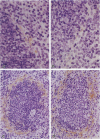Abstract
Apolipoprotein E (apoE) is a constituent of lipoproteins other than low-density lipoprotein, and it principally acts in the transport and metabolism of plasma cholesterol and triglyceride. ApoE is a minor constituent of various kinds of amyloidoses and may play a role as a pathological chaperone for fibrillogenesis of amyloid fibril protein with the amyloid P component and proteoglycans. In this study, we examined the role of apoE in amyloidogenesis in vivo in apoE-deficient mutant mice with amyloid A protein (AA) amyloidosis induced by inflammatory stimulation. Amyloid deposition was seen in six of nine C57BL/6J control mice and in six of eight apoE-deficient mutant mice after the intraperitoneal and subcutaneous injections of the mixture of complete Freund's adjuvant and Mycobacterium butyricum. Moreover, amyloid deposition in apoE-deficient mice as well as C57BL/6J control mice started 48 or 72 hours after injection of amyloid-enhancing factor and silver nitrate, although the amount of amyloid deposit in C57BL/6J control mice was slightly larger than that in apoE-deficient mice. These amyloid deposits reacted with anti-mouse AA antibody were seen in the perifollicular area of the spleen. Immunoreactivity of apoE was seen irregularly in the amyloid deposits of C57BL/6J control mice but not in the amyloid deposit of apoE-deficient mice. From these results, we concluded that apoE is not always necessary for amyloid deposition and that the existence of apoE might slightly accelerate AA amyloid deposition in the earliest phase of AA amyloid deposition.
Full text
PDF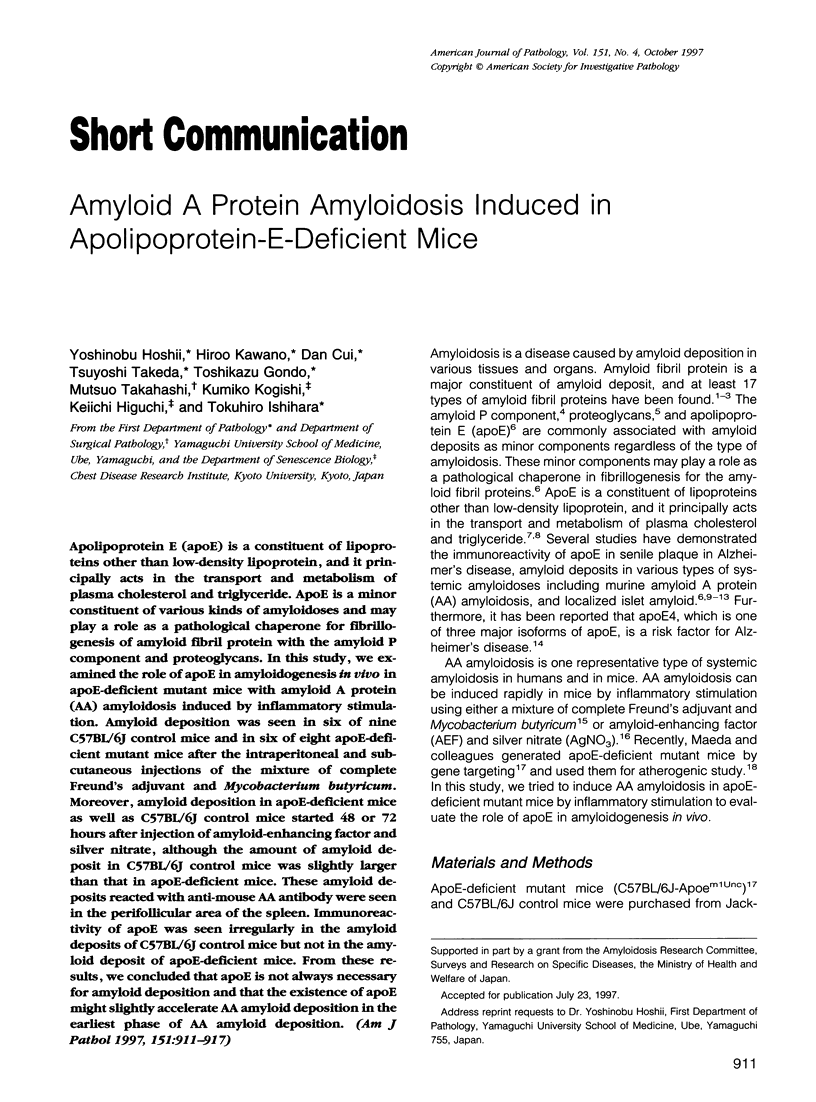
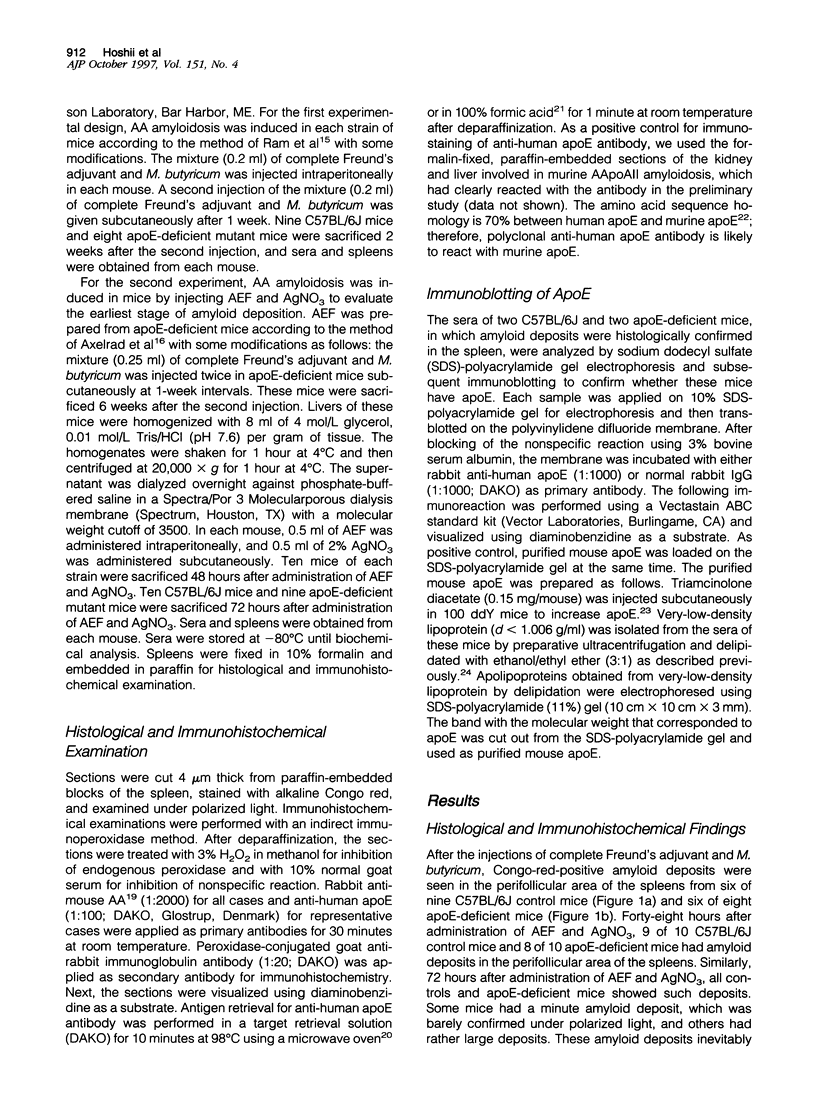

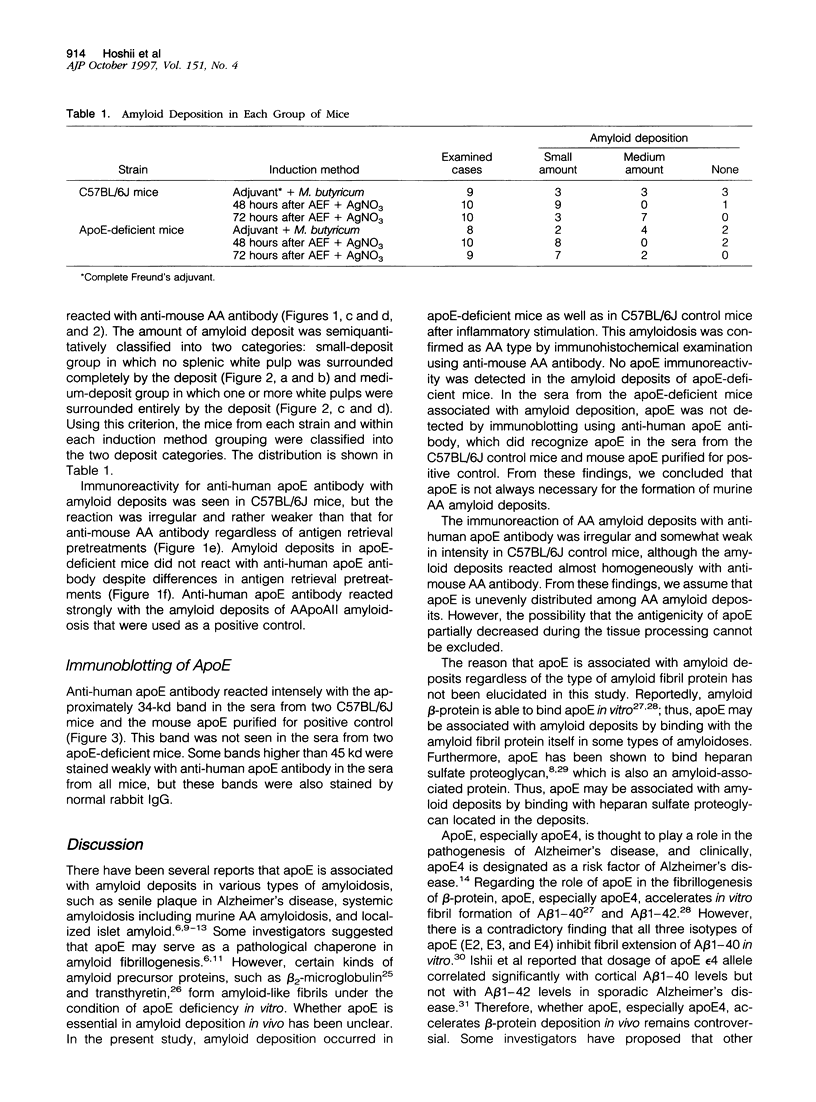


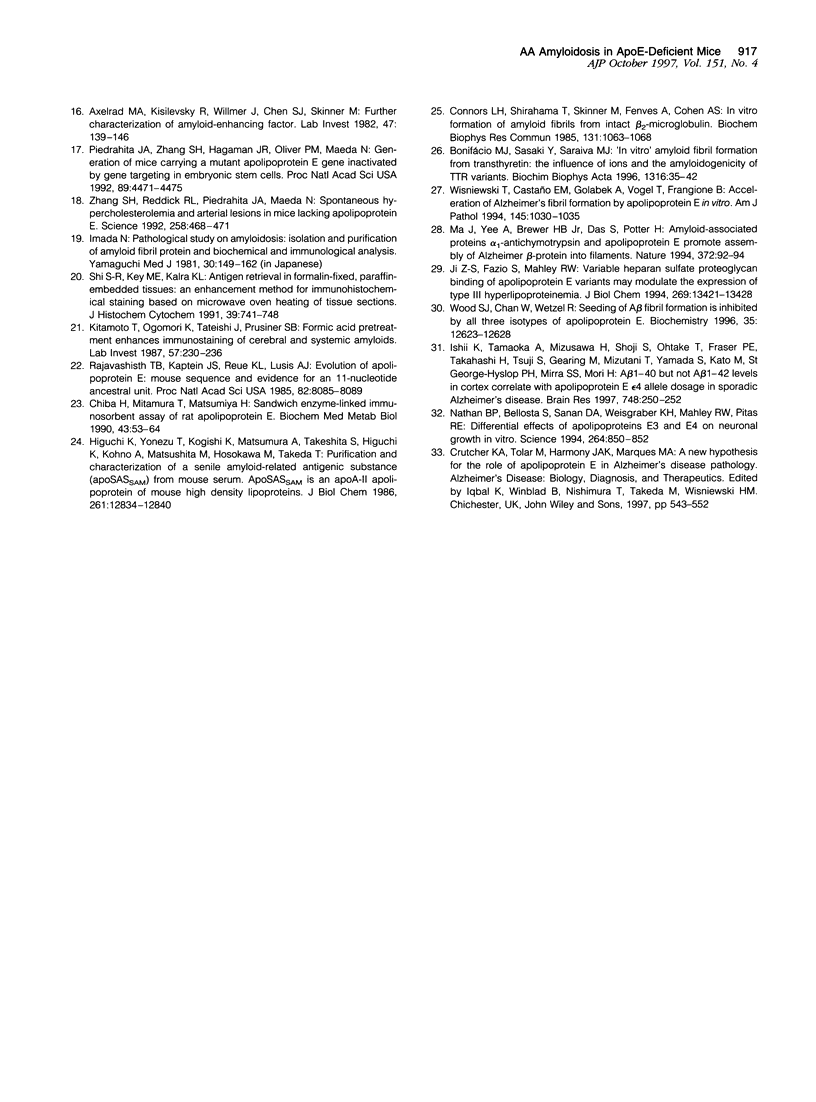
Images in this article
Selected References
These references are in PubMed. This may not be the complete list of references from this article.
- Axelrad M. A., Kisilevsky R., Willmer J., Chen S. J., Skinner M. Further characterization of amyloid-enhancing factor. Lab Invest. 1982 Aug;47(2):139–146. [PubMed] [Google Scholar]
- Benson M. D., Liepnieks J., Uemichi T., Wheeler G., Correa R. Hereditary renal amyloidosis associated with a mutant fibrinogen alpha-chain. Nat Genet. 1993 Mar;3(3):252–255. doi: 10.1038/ng0393-252. [DOI] [PubMed] [Google Scholar]
- Bonifácio M. J., Sakaki Y., Saraiva M. J. 'In vitro' amyloid fibril formation from transthyretin: the influence of ions and the amyloidogenicity of TTR variants. Biochim Biophys Acta. 1996 May 24;1316(1):35–42. doi: 10.1016/0925-4439(96)00014-2. [DOI] [PubMed] [Google Scholar]
- Chargé S. B., Esiri M. M., Bethune C. A., Hansen B. C., Clark A. Apolipoprotein E is associated with islet amyloid and other amyloidoses: implications for Alzheimer's disease. J Pathol. 1996 Aug;179(4):443–447. doi: 10.1002/(SICI)1096-9896(199608)179:4<443::AID-PATH612>3.0.CO;2-7. [DOI] [PubMed] [Google Scholar]
- Chiba H., Mitamura T., Matsumiya H. Sandwich enzyme-linked immunosorbent assay of rat apolipoprotein E. Biochem Med Metab Biol. 1990 Feb;43(1):53–64. doi: 10.1016/0885-4505(90)90008-o. [DOI] [PubMed] [Google Scholar]
- Connors L. H., Shirahama T., Skinner M., Fenves A., Cohen A. S. In vitro formation of amyloid fibrils from intact beta 2-microglobulin. Biochem Biophys Res Commun. 1985 Sep 30;131(3):1063–1068. doi: 10.1016/0006-291x(85)90198-6. [DOI] [PubMed] [Google Scholar]
- Gallo G., Wisniewski T., Choi-Miura N. H., Ghiso J., Frangione B. Potential role of apolipoprotein-E in fibrillogenesis. Am J Pathol. 1994 Sep;145(3):526–530. [PMC free article] [PubMed] [Google Scholar]
- Higuchi K., Yonezu T., Kogishi K., Matsumura A., Takeshita S., Higuchi K., Kohno A., Matsushita M., Hosokawa M., Takeda T. Purification and characterization of a senile amyloid-related antigenic substance (apoSASSAM) from mouse serum. apoSASSAM is an apoA-II apolipoprotein of mouse high density lipoproteins. J Biol Chem. 1986 Sep 25;261(27):12834–12840. [PubMed] [Google Scholar]
- Ishii K., Tamaoka A., Mizusawa H., Shoji S., Ohtake T., Fraser P. E., Takahashi H., Tsuji S., Gearing M., Mizutani T. Abeta1-40 but not Abeta1-42 levels in cortex correlate with apolipoprotein E epsilon4 allele dosage in sporadic Alzheimer's disease. Brain Res. 1997 Feb 14;748(1-2):250–252. doi: 10.1016/s0006-8993(96)01363-7. [DOI] [PubMed] [Google Scholar]
- Ji Z. S., Fazio S., Mahley R. W. Variable heparan sulfate proteoglycan binding of apolipoprotein E variants may modulate the expression of type III hyperlipoproteinemia. J Biol Chem. 1994 May 6;269(18):13421–13428. [PubMed] [Google Scholar]
- Kindy M. S., King A. R., Perry G., de Beer M. C., de Beer F. C. Association of apolipoprotein E with murine amyloid A protein amyloid. Lab Invest. 1995 Oct;73(4):469–475. [PubMed] [Google Scholar]
- Kitamoto T., Ogomori K., Tateishi J., Prusiner S. B. Formic acid pretreatment enhances immunostaining of cerebral and systemic amyloids. Lab Invest. 1987 Aug;57(2):230–236. [PubMed] [Google Scholar]
- Ma J., Yee A., Brewer H. B., Jr, Das S., Potter H. Amyloid-associated proteins alpha 1-antichymotrypsin and apolipoprotein E promote assembly of Alzheimer beta-protein into filaments. Nature. 1994 Nov 3;372(6501):92–94. doi: 10.1038/372092a0. [DOI] [PubMed] [Google Scholar]
- Mahley R. W. Apolipoprotein E: cholesterol transport protein with expanding role in cell biology. Science. 1988 Apr 29;240(4852):622–630. doi: 10.1126/science.3283935. [DOI] [PubMed] [Google Scholar]
- Namba Y., Tomonaga M., Kawasaki H., Otomo E., Ikeda K. Apolipoprotein E immunoreactivity in cerebral amyloid deposits and neurofibrillary tangles in Alzheimer's disease and kuru plaque amyloid in Creutzfeldt-Jakob disease. Brain Res. 1991 Feb 8;541(1):163–166. doi: 10.1016/0006-8993(91)91092-f. [DOI] [PubMed] [Google Scholar]
- Nathan B. P., Bellosta S., Sanan D. A., Weisgraber K. H., Mahley R. W., Pitas R. E. Differential effects of apolipoproteins E3 and E4 on neuronal growth in vitro. Science. 1994 May 6;264(5160):850–852. doi: 10.1126/science.8171342. [DOI] [PubMed] [Google Scholar]
- Pepys M. B., Hawkins P. N., Booth D. R., Vigushin D. M., Tennent G. A., Soutar A. K., Totty N., Nguyen O., Blake C. C., Terry C. J. Human lysozyme gene mutations cause hereditary systemic amyloidosis. Nature. 1993 Apr 8;362(6420):553–557. doi: 10.1038/362553a0. [DOI] [PubMed] [Google Scholar]
- Piedrahita J. A., Zhang S. H., Hagaman J. R., Oliver P. M., Maeda N. Generation of mice carrying a mutant apolipoprotein E gene inactivated by gene targeting in embryonic stem cells. Proc Natl Acad Sci U S A. 1992 May 15;89(10):4471–4475. doi: 10.1073/pnas.89.10.4471. [DOI] [PMC free article] [PubMed] [Google Scholar]
- Rajavashisth T. B., Kaptein J. S., Reue K. L., Lusis A. J. Evolution of apolipoprotein E: mouse sequence and evidence for an 11-nucleotide ancestral unit. Proc Natl Acad Sci U S A. 1985 Dec;82(23):8085–8089. doi: 10.1073/pnas.82.23.8085. [DOI] [PMC free article] [PubMed] [Google Scholar]
- Ram J. S., DeLellis R. A., Glenner G. G. Amyloid. 3. A method for rapid induction of amyloidosis in mice. Int Arch Allergy Appl Immunol. 1968;34(2):201–204. [PubMed] [Google Scholar]
- Saunders A. M., Strittmatter W. J., Schmechel D., George-Hyslop P. H., Pericak-Vance M. A., Joo S. H., Rosi B. L., Gusella J. F., Crapper-MacLachlan D. R., Alberts M. J. Association of apolipoprotein E allele epsilon 4 with late-onset familial and sporadic Alzheimer's disease. Neurology. 1993 Aug;43(8):1467–1472. doi: 10.1212/wnl.43.8.1467. [DOI] [PubMed] [Google Scholar]
- Shi S. R., Key M. E., Kalra K. L. Antigen retrieval in formalin-fixed, paraffin-embedded tissues: an enhancement method for immunohistochemical staining based on microwave oven heating of tissue sections. J Histochem Cytochem. 1991 Jun;39(6):741–748. doi: 10.1177/39.6.1709656. [DOI] [PubMed] [Google Scholar]
- Snow A. D., Willmer J., Kisilevsky R. Sulfated glycosaminoglycans: a common constituent of all amyloids? Lab Invest. 1987 Jan;56(1):120–123. [PubMed] [Google Scholar]
- Weisgraber K. H. Apolipoprotein E: structure-function relationships. Adv Protein Chem. 1994;45:249–302. doi: 10.1016/s0065-3233(08)60642-7. [DOI] [PubMed] [Google Scholar]
- Wisniewski T., Castaño E. M., Golabek A., Vogel T., Frangione B. Acceleration of Alzheimer's fibril formation by apolipoprotein E in vitro. Am J Pathol. 1994 Nov;145(5):1030–1035. [PMC free article] [PubMed] [Google Scholar]
- Wisniewski T., Frangione B. Apolipoprotein E: a pathological chaperone protein in patients with cerebral and systemic amyloid. Neurosci Lett. 1992 Feb 3;135(2):235–238. doi: 10.1016/0304-3940(92)90444-c. [DOI] [PubMed] [Google Scholar]
- Wood S. J., Chan W., Wetzel R. Seeding of A beta fibril formation is inhibited by all three isotypes of apolipoprotein E. Biochemistry. 1996 Sep 24;35(38):12623–12628. doi: 10.1021/bi961074j. [DOI] [PubMed] [Google Scholar]
- Yamada T., Kakihara T., Gejyo F., Okada M. A monoclonal antibody recognizing apolipoprotein E peptides in systemic amyloid deposits. Ann Clin Lab Sci. 1994 May-Jun;24(3):243–249. [PubMed] [Google Scholar]
- Zhang S. H., Reddick R. L., Piedrahita J. A., Maeda N. Spontaneous hypercholesterolemia and arterial lesions in mice lacking apolipoprotein E. Science. 1992 Oct 16;258(5081):468–471. doi: 10.1126/science.1411543. [DOI] [PubMed] [Google Scholar]




